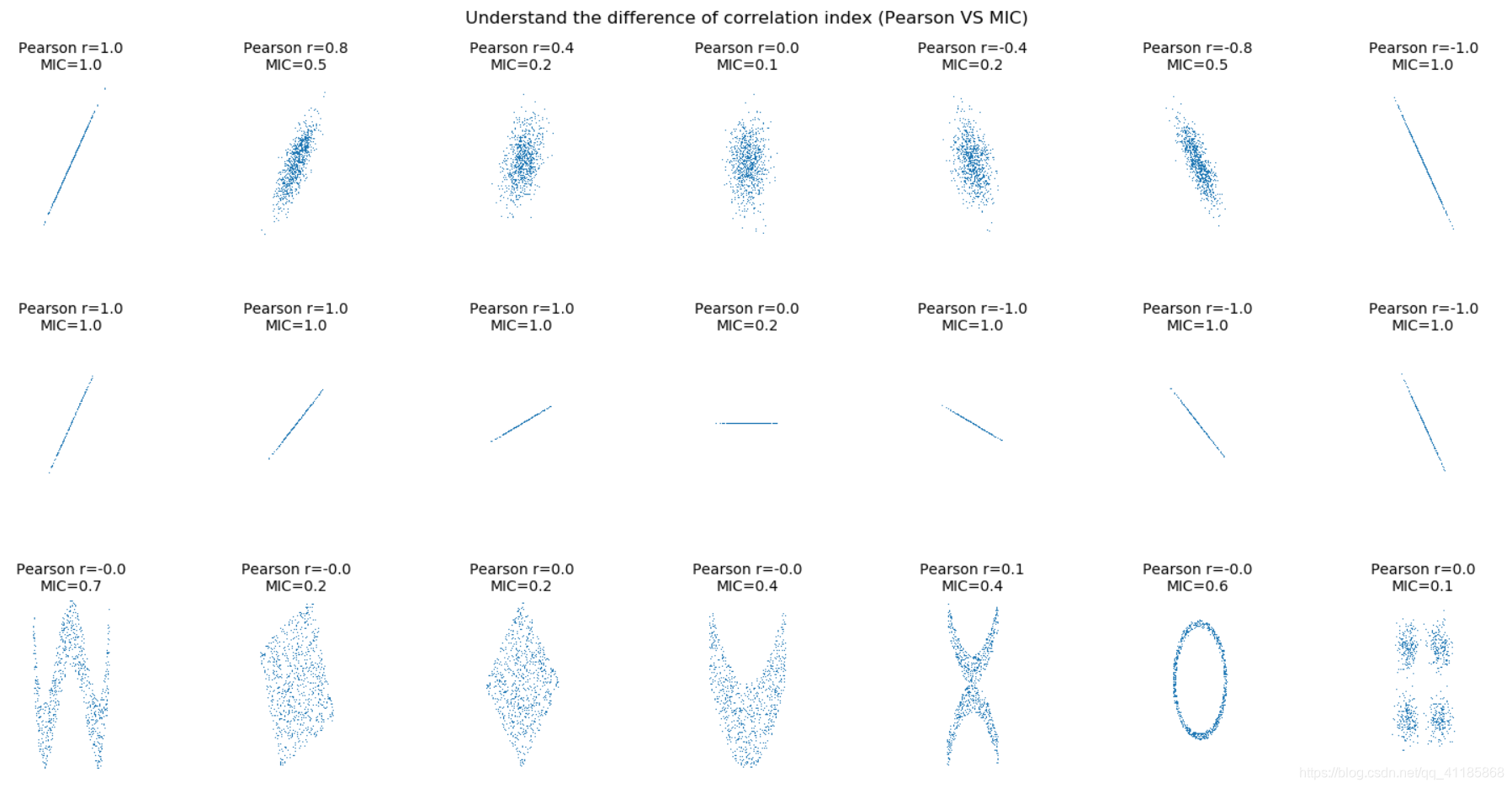ML之MIC:利用有无噪音的正余弦函数理解相关性指标的不同(多图绘制Pearson系数、最大信息系数MIC)
ML之MIC:利用有无噪音的正余弦函数理解相关性指标的不同(多图绘制Pearson系数、最大信息系数MIC)
目录
利用有无噪音的正余弦函数理解相关性指标的不同(多图绘制Pearson系数、最大信息系数MIC)
利用有无噪音的正余弦函数理解相关性指标的不同(多图绘制Pearson系数、最大信息系数MIC)
输出结果

实现代码
-
-
-
- ML之MIC:利用有无噪音的正余弦函数理解相关性指标的不同(多图绘制Pearson系数、最大信息系数MIC)
-
- import numpy as np
- import matplotlib.pyplot as plt
- from minepy import MINE
-
-
- def mysubplot(x, y, numRows, numCols, plotNum,
- xlim=(-4, 4), ylim=(-4, 4)):
-
- r = np.around(np.corrcoef(x, y)[0, 1], 1)
- mine = MINE(alpha=0.6, c=15)
- mine.compute_score(x, y)
- mic = np.around(mine.mic(), 1)
- ax = plt.subplot(numRows, numCols, plotNum,
- xlim=xlim, ylim=ylim)
- ax.set_title('Pearson r=%.1f\nMIC=%.1f' % (r, mic),fontsize=10)
- ax.set_frame_on(False)
- ax.axes.get_xaxis().set_visible(False)
- ax.axes.get_yaxis().set_visible(False)
- ax.plot(x, y, ',')
- ax.set_xticks([])
- ax.set_yticks([])
- return ax
-
- def rotation(xy, t):
- return np.dot(xy, [[np.cos(t), -np.sin(t)],
- [np.sin(t), np.cos(t)]])
-
- def mvnormal(n=1000):
- cors = [1.0, 0.8, 0.4, 0.0, -0.4, -0.8, -1.0]
- for i, cor in enumerate(cors):
- cov = [[1, cor],[cor, 1]]
- xy = np.random.multivariate_normal([0, 0], cov, n)
- mysubplot(xy[:, 0], xy[:, 1], 3, 7, i+1)
-
- def rotnormal(n=1000):
- ts = [0, np.pi/12, np.pi/6, np.pi/4, np.pi/2-np.pi/6,
- np.pi/2-np.pi/12, np.pi/2]
- cov = [[1, 1],[1, 1]]
- xy = np.random.multivariate_normal([0, 0], cov, n)
- for i, t in enumerate(ts):
- xy_r = rotation(xy, t)
- mysubplot(xy_r[:, 0], xy_r[:, 1], 3, 7, i+8)
-
- def others(n=1000):
- x = np.random.uniform(-1, 1, n)
- y = 4*(x**2-0.5)**2 + np.random.uniform(-1, 1, n)/3
- mysubplot(x, y, 3, 7, 15, (-1, 1), (-1/3, 1+1/3))
-
- y = np.random.uniform(-1, 1, n)
- xy = np.concatenate((x.reshape(-1, 1), y.reshape(-1, 1)), axis=1)
- xy = rotation(xy, -np.pi/8)
- lim = np.sqrt(2+np.sqrt(2)) / np.sqrt(2)
- mysubplot(xy[:, 0], xy[:, 1], 3, 7, 16, (-lim, lim), (-lim, lim))
-
- xy = rotation(xy, -np.pi/8)
- lim = np.sqrt(2)
- mysubplot(xy[:, 0], xy[:, 1], 3, 7, 17, (-lim, lim), (-lim, lim))
-
- y = 2*x**2 + np.random.uniform(-1, 1, n)
- mysubplot(x, y, 3, 7, 18, (-1, 1), (-1, 3))
-
- y = (x**2 + np.random.uniform(0, 0.5, n)) * \
- np.array([-1, 1])[np.random.random_integers(0, 1, size=n)]
- mysubplot(x, y, 3, 7, 19, (-1.5, 1.5), (-1.5, 1.5))
-
- y = np.cos(x * np.pi) + np.random.uniform(0, 1/8, n)
- x = np.sin(x * np.pi) + np.random.uniform(0, 1/8, n)
- mysubplot(x, y, 3, 7, 20, (-1.5, 1.5), (-1.5, 1.5))
-
- xy1 = np.random.multivariate_normal([3, 3], [[1, 0], [0, 1]], int(n/4))
- xy2 = np.random.multivariate_normal([-3, 3], [[1, 0], [0, 1]], int(n/4))
- xy3 = np.random.multivariate_normal([-3, -3], [[1, 0], [0, 1]], int(n/4))
- xy4 = np.random.multivariate_normal([3, -3], [[1, 0], [0, 1]], int(n/4))
- xy = np.concatenate((xy1, xy2, xy3, xy4), axis=0)
- mysubplot(xy[:, 0], xy[:, 1], 3, 7, 21, (-7, 7), (-7, 7))
-
- plt.figure(facecolor='white')
- mvnormal(n=800)
- rotnormal(n=200)
- others(n=800)
- plt.tight_layout()
-
- plt.suptitle('Understand the difference of correlation index (Pearson VS MIC)')
- plt.show()
-
-
-
-
-
-
-
-
网站声明:如果转载,请联系本站管理员。否则一切后果自行承担。
赞同 0
评论 0 条
- 上周热门
- Kingbase用户权限管理 2020
- 信刻全自动光盘摆渡系统 1749
- 信刻国产化智能光盘柜管理系统 1419
- 银河麒麟添加网络打印机时,出现“client-error-not-possible”错误提示 1014
- 银河麒麟打印带有图像的文档时出错 924
- 银河麒麟添加打印机时,出现“server-error-internal-error” 715
- 麒麟系统也能完整体验微信啦! 657
- 统信桌面专业版【如何查询系统安装时间】 633
- 统信操作系统各版本介绍 624
- 统信桌面专业版【全盘安装UOS系统】介绍 598
- 本周热议
- 我的信创开放社区兼职赚钱历程 40
- 今天你签到了吗? 27
- 信创开放社区邀请他人注册的具体步骤如下 15
- 如何玩转信创开放社区—从小白进阶到专家 15
- 方德桌面操作系统 14
- 我有15积分有什么用? 13
- 用抖音玩法闯信创开放社区——用平台宣传企业产品服务 13
- 如何让你先人一步获得悬赏问题信息?(创作者必看) 12
- 2024中国信创产业发展大会暨中国信息科技创新与应用博览会 9
- 中央国家机关政府采购中心:应当将CPU、操作系统符合安全可靠测评要求纳入采购需求 8
热门标签更多

